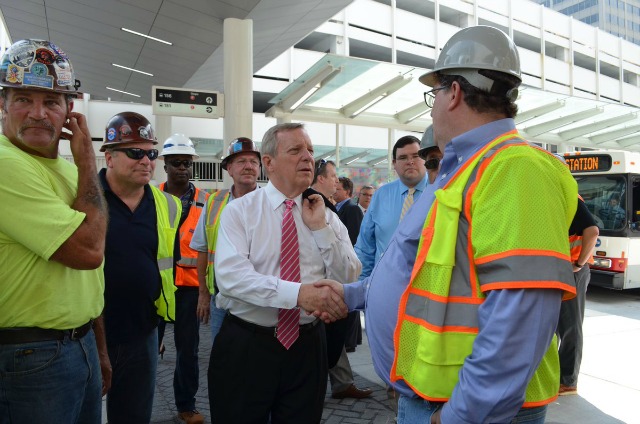New Union Station Transit Center Should Ease CTA Transfer Headaches
By Stephen Gossett in News on Aug 31, 2016 8:10PM

Courtesy Senator Dick Durbin
One of the city’s most high-profile transit upgrades will be open and operational very soon.
Mayor Rahm Emanuel and Sen. Dick Durbin announced on Tuesday that the new Union Station Transit Center, which better connects Metra and Amtrak riders to CTA buses, will be up and running Sunday, Sept. 4. The development is intended to ease transfers and decrease traffic in the area—certainly a desirable outcome, as anyone who's had to transfer from a Union Station train to a bus can attest.
The facility features a weather-protected boarding area and underground pedway access to Union Station, along with bus trackers and Ventra machines. Located at Jackson Boulevard. between Canal and Clinton streets, just south of the station, the site was formerly a parking lot. The new hub will service six CTA bus routes:
- #1 Bronzeville/Union (Will stop at Jackson Blvd.)
- # 28 Stony Island
- #121 Union/Streeterville Express (Will stop at Jackson Blvd.)
- #124 Navy Pier
- #151 Sheridan
- #156 LaSalle
“The opening of this transit center is another step in our plan to make Union Station a true transit hub for the city of Chicago,” Emanuel said in a statement. “By making it easier to move from a bus to a train and improving nearby traffic flow, we are making the neighborhood more attractive for residents, visitors and businesses. By renovating and restoring Union Station, we are making Chicago even stronger with 21st-century infrastructure that can meet the demands of a 21st century economy.”
At the same time, CDOT is finishing up improvements on Canal St., with one side dedicated to bus and wheelchair pickup and drop-off, and the other side used for all other traffic
“CDOT is very excited to have built the USTC and to be wrapping up the work on Canal Street as part of the Loop Link,” CDOT Commissioner Rebekah Scheinfeld said in a statement. “Both of these projects deliver real improvements in terms of safety and mobility for all modes of transportation, especially for pedestrians and transit riders.”
The project cost $41.5 million, most of which came from federal funds.